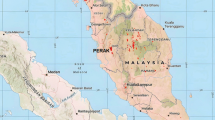Summary
Eleven communities in limestone areas of Shikoku have been described and considered from a phytosociological point of view.
The evergreen broad-leaved forests and scrubs in the warm temperate region are included in the Camellietea japonicae, and deciduous broad-leaved and coniferous forests excluding the Carpinus turczaninovii-Zabelia integrifolia association in the cool temperate region belong to the Fagetea crenatae. These classes are inclusive of climatic climaxes, and the major dominants are not characteristic of limestone areas. A noticeable fact, however, is the occurrence of the Quercus glauca-Nandina domestica association in limestone areas, where the Castanopsis cuspidata forests prevailing in climatic climaxes are replaced by this association.
The limestone vegetation varies considerably with the situation and the physiographic factors, and the most characteristic community typified by the Carpinus turczaninovii-Zabelia integrifolia association appears in xeric sites. This association, having a wide altitudinal range, is not included in any known classes, and the floristic composition is particularized by a large number of endemic and disjunctive elements.
Zusammenfassung
Als Ergebnis der pflanzensoziologischen Studien über Wälder und Sträucher in Kalkgegenden von Shikoku, Süd-Japan, wurden elf Pflanzengesellschaften beschrieben.
Die immergrünen Wälder und Sträucher im warmtemperierten Gebiet werden in die Klasse Camellietea japonicae eingereiht, während im kalttemperierten Gebiet die Sommergrün- und Nadelwälder ausschließlich der Carpinus turczaninovii-Zabelia integrifolia-Assoziation, Klasse Fagetea crenatae, gehören.
Diese Klassen bestehen aus klimatischen Klimaxgesellschaften, und die wichtigeren Dominanten sind keine Kalk-Spezialisten. Es ist aber zu bemerken, daß sich die Quercus glauca-Nandina domestica-Assoziation in Kalkgegenden befindet, wo die in klimatischen Klimaxgesellschaften überwiegenden Castanopsis cuspidata-Wälder durch diese Assoziation ersetzt werden.
Mit dem Standort und den physiographischen Faktoren verändert sich die Kalkvegetation ansehnlich, und die durch die Carpinus turczaninovii-Zabelia integrifolia-Assoziation höchst charakteristisch dargestellte Pflanzengesellschaft erscheint in trockenen Standorten. Diese Assoziation wird in keine der bekannten Klassen eingeschlossen, die floristische Zusammensetzung kennzeichnet sich durch eine große Anzahl endemischer und disjunkter Elemente.
Similar content being viewed by others
Literatur
Braun-Blanquet, J. 1959 — Grundfragen und Aufgaben der Pflanzensoziologie. Vistas in Bot. 145–171, Comm. S.I.G.M.A. No. 147.
Horikawa, Y. & Sasaki, Y. 1959a — Phytosociological studies on the vegetation of Geihoku-district (the Sandankyo Gorge and its vicinity), Hiroshima Prefecture. Sci. Res. Sandankyo Gorge Yawata Highland 85–107. (In Japanese with English summary).
Horikawa, Y. & Sasaki, Y. 1959b — Vegetation und Flora der Bihoku-Gegende, Provinz Hiroshima. Chugoku Sanchi Kokutei Koen Kohochi Gakujutsu Chosa Hokoku 43–68. (In Japanese).
Karizumi, N. & Tokui, O. 1956 — On the beech forests in Takanawa Peninsula, Shikoku. J. Jap. For. Soc. 38: 263–268. (In Japanese with English summary).
Miyawaki, A. & Ohba, T. 1963 — Castanopsis Sieboldii-Wälder auf den Amami-Inseln. Sci. Rep. Yokohama Nat. Univ. Sect. II, No. 9: 31–48.
Miyawaki, A., Ohba, T. & Murase, N. 1964 — Pflanzensoziologische Studien über die Vegetation in Tanzawa-Gebirge, Provinz Kanagawa. Tanzawa/Oyama Gakujutsu Chosa Hokokusho 54–102. (In Japanese with German and English summary).
Shimizu, T. 1959 — Floristic features of the plant community on the calcareous field with special reference to the case of Mt. Ibuki, middle Japan. Jap. J. Ecol. 9: 128–134. (In Japanese with English summary).
Shimizu, T. 1962–3 — Studies on the limestone flora of Japan and Taiwan, I, II. J. Fac. Textile Sci. Technol., Shinshu Univ. Ser. A, No. 11: 1–105; No. 12: 1–88.
Suzuki, T. 1949 — The temperate forest vegetation in the upper stream area of River Tenryu. Gijutsu Kenkyu No. 1: 77–91. (In Japanese with English summary).
Suzuki, T. 1951 — The warm-temperate forest vegetation of Osumi Peninsula. Bull. Tokyo Univ. For. No. 41: 57–73. (In Japanese with English summary).
Suzuki, T. 1952 — The forest climaxes in East Asia. pp. 137, Tokyo. (In Japanese).
Suzuki, T. 1954 — L'Alliance du Shiion Sieboldi. Vegetatio 5–6: 361–372.
Suzuki, T. & Hatiya, K. 1951 — The forest vegetation of Izu Peninsula. Bull. Tokyo Univ. For. No. 39: 145–169. (In Japanese with English summary).
Yamanaka, T. 1955 — Studies on the limestone vegetation in Shikoku, Japan. Res. Rep. Kochi Univ. 4, 2: 1–12.
Yamanaka, T. 1961 — Abies firma and Tsuga sieboldii forests in Shikoku (Forest climaxes in Shikoku, Japan, 1). Res. Rep. Kochi Univ. (Nat. Sci. I), 10: 19–32.
Yamanaka, T. 1963 — The Carpinus turczaninovii community on the Island “Shodoshima”. Sci. Rep. Tohoku Univ. Ser. 4, 29: 195–200.
Yamanaka, T. 1965 — The Carpinus turczaninovii community in Japan. Res. Rep. Kochi Univ. (Nat. Sci. I), 13: 23–29. (In Japanese with English summary).
Yamanaka, T. 1966a — The limestone vegetation in middle Kyushu, with special reference to the Quercus glauca and the Carpinus turczaninovii community. Res. Rep. Kochi Univ. (Nat. Sci. I), 15: 1–9. (In Japanese with English summary).
Yamanaka, T. 1966b — On the Nandino-Cyclobalanopsidetum. Res. Rep. Kochi Univ. (Nat. Sci. I), 15: 11–19. (In Japanese with English summary).
Author information
Authors and Affiliations
Rights and permissions
About this article
Cite this article
Yamanaka, T. The forest and scrub vegetation in limestone areas of Shikoku, Japan. Vegetatio Acta Geobot 19, 286–307 (1969). https://doi.org/10.1007/BF00259016
Issue Date:
DOI: https://doi.org/10.1007/BF00259016




